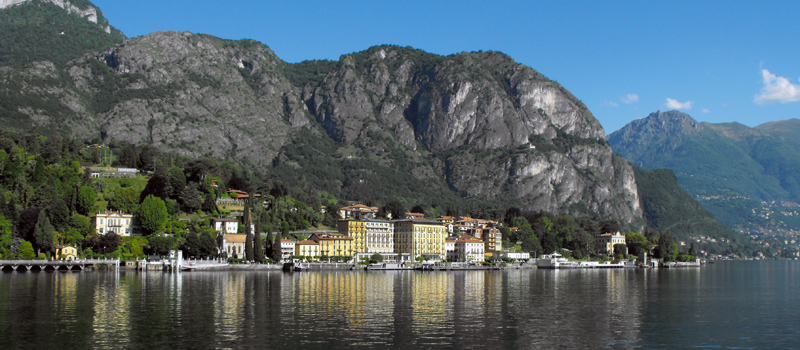
The Menaggio harbour which seems to jealously protect the boats from Lake Como's unpredictable water; a coastal road, with tree-lined stretches, which generates varying, uneven spaces: now tight spaces full of parked cars. Now a short widening with welcoming arcades under which the atmosphere of the lake can be sensed; now access roads to out-of-the-way piazzas from which branch out the narrow roads of the ancient layout. There are many recreation centres and hotels, and we recommend a walk along the lake shore, where between palms and budding flowerbeds, stands the Monumento alla Tessitrice (lady weaver).
There are buildings in Menaggio which seem to have been unable to obey the logic of the continuous line facing Lake Como, because the strada Regina got in the way, and the need to organise civil life with buildings, hotels and homes imposed an apparently haphazard establishment. The homes of central Menaggio seem to spill into the valley, at the outlet of the Menaggina which connects Lake Como with the Ceresio.
Unfortunately, the railway, which at one time transported tourists as well as the valley's inhabitants devoted to trade, was removed years ago. The Menaggio area was a very important communication route in past centuries because the Ticino emigrants travelled it to reach the Valtellina and to enter the land of the Venetian Republic and vice-versa, it was the road to reach Porlezza, to overlook into the hospitable, mild Valsolda.
Menaggio in that way, centralized and sorted people and things, living off the lake, toward Bellagio as well as toward Varenna, and from the land, toward Lugano, Campione, Mendrisio and the villages of Varesotto. In 1945 Menaggio came back into the scene for the landscape of the Colonna Mussolini stopped at the Castellino da Castello school.

In Pianello the International Museum of Vintage Boats is definitely worth a visit, set up in an old spinning mill which houses over four hundred boats that recount two millennia of nautical history here on Lake Como, a unique exhibition.
Pianello del Lario
Dried Shad (Agone), called Missoltini or Missultin, were at one time a precious food for inhabitants of Lake Como, the particular processing allowed them to be conserved for more than a year, excellent traditional Lake Como cuisine.
Lario Cuisine
In Griante stands the ancient church dedicated to Saints Nabore and Felice, while with a short excursion it is possible to reach the church of San Martino suspended on the homonymous stone in a splendid panoramic position.
Griante - Cadenabbia